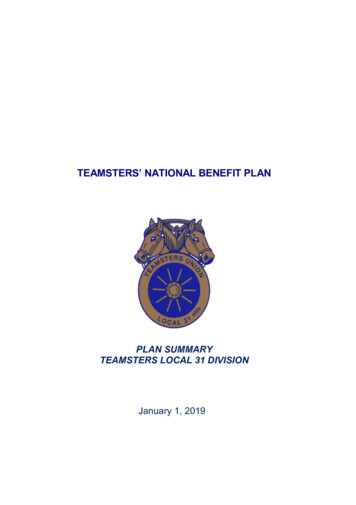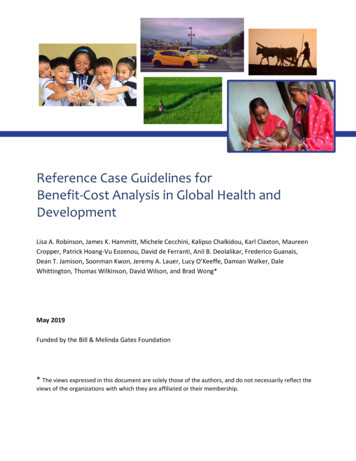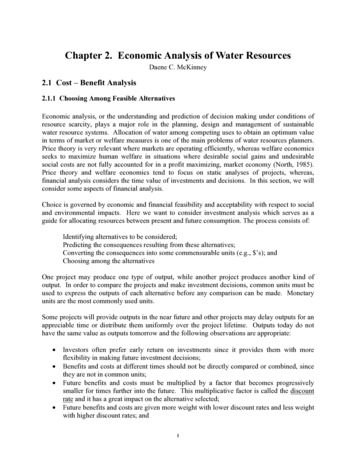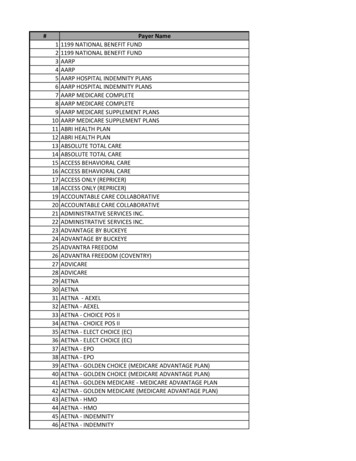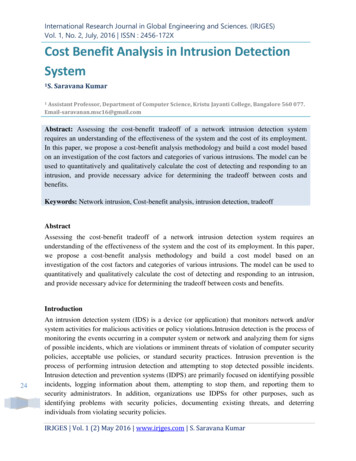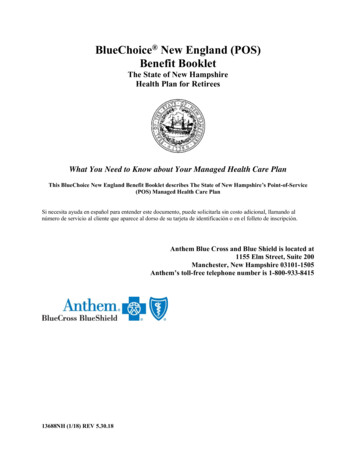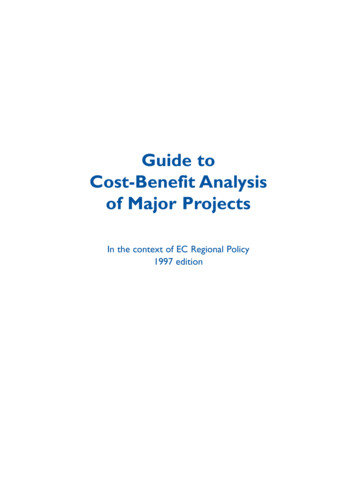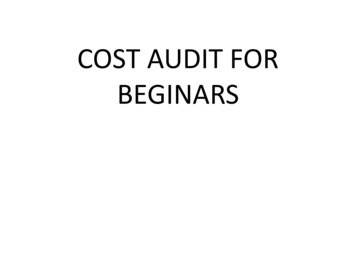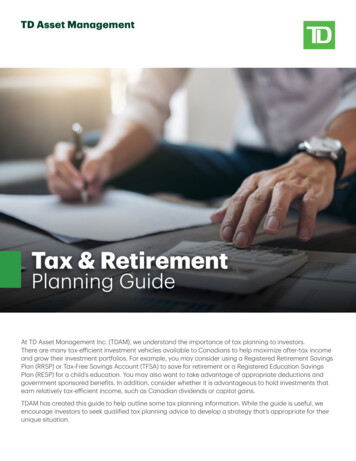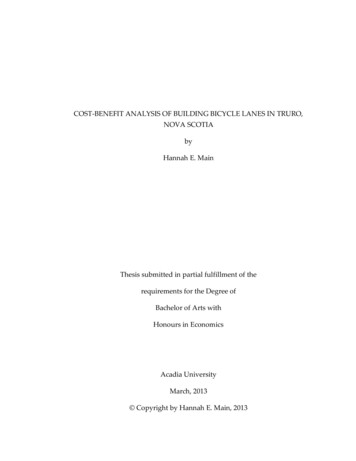
Transcription
COST-BENEFIT ANALYSIS OF BUILDING BICYCLE LANES IN TRURO,NOVA SCOTIAbyHannah E. MainThesis submitted in partial fulfillment of therequirements for the Degree ofBachelor of Arts withHonours in EconomicsAcadia UniversityMarch, 2013 Copyright by Hannah E. Main, 2013
This thesis by Hannah E. Mainis accepted in its present form by theDepartment of Economicsas satisfying the thesis requirements for the degree ofBachelor of Arts with HonoursApproved by Thesis SupervisorBrian VanBlarcomDateApproved by the Head of the DepartmentBrian VanBlarcomDateApproved by the Honours CommitteePritam RanjaniiDate
I, Hannah E. Main, grant permission to the University Librarian at AcadiaUniversity to reproduce, loan or distribute copies of my thesis in microform,paper or electronic formats on a non-profit basis. I however, retain the copyrightin my thesis.Signature of AuthorDateiii
AcknowledgementsI would like to thank Professor Brian VanBlarcom for guiding me through thisprocess, and for the other professors in the Department of Economics at Acadia.The advice and guidance was very much appreciated. I also thank my family fortheir continued support.iv
Table of ContentsAcknowledgements . ivTable of Contents . vList of Tables . viAbstract. vii1. Introduction .12. Background .23. Literature Review .43.1 Environmental and health benefits of bicycling .43.2 Role of bicycle infrastructure .63.3 Cost-benefit analysis of bikeway networks .84. Methods .124.1 Fundamentals of cost-benefit analysis .124.2 Specifying the set of alternative projects .124.3 Identifying the impact categories and selecting measurement indicators .134.4 Predicting the impacts quantitatively over the life of the project .154.5 Monetizing all impacts .174.6 Discounting benefits and costs to obtain present values .185. Results .205. 1 Benefits of switching from driving to cycling .205.2 Costs of installing bicycle lanes .236. Conclusion .27References .30v
List of TablesTable 1: Explanation of cost categories . 14Table 2: Costs per vehicle-kilometre, car and bicycle, (2012 CAD ) . 21Table 3: Truro residents’ mode of transportation to work . 22Table 4: Annual benefits of installing bicycle lane network . 23Table 5: Net present value of benefits . 23Table 6: Net present value of net benefits if construction costs up-front . 24Table 7: Construction costs amortized over 20 years. 24Table 8: Net present value of net benefits if construction costs are borrowed . 25vi
AbstractWith rising gas prices, the threat of climate change, and the growingproblem of obesity, bikeway networks have become increasingly popular overthe past few years as an infrastructure to encourage bicycling. This thesisexamines the feasibility of building bicycle lanes in the town of Truro. The costsof building a bicycle lane network in Truro are compared with the benefits. Thebenefits of building bicycle lanes are the benefits of switching from car travel tobicycle travel. The internal and external costs and benefits are quantifiedfollowing Litman (2009). To compute these benefits, it is necessary to estimatehow many people would be likely to switch from using a motor vehicle to usinga bicycle if indeed a bicycle lane was in place, and how many additionalkilometres would be traveled by bicycle if there was a bike lane. These estimatesare found using Statistics Canada census data on number of commuters on eachmode of transportation, data on average commuting distance, and previousresearch on the impact of bicycle infrastructure on bicycle commuting. Oncethese estimates have been completed, the benefits of bicycling are compared withthe costs of construction of the bicycle lane network to find the estimated netbenefits. Results show that when only commuters are taken into account, costs ofbuilding a bicycle lane network exceed benefits.vii
1. IntroductionWith rising gas prices, the threat of climate change, and the growingproblem of obesity, bikeway networks have become increasingly popular overthe past few years as an infrastructure to encourage bicycling. The health benefitsto the individual cycling and environmental benefits of not driving a motorvehicle are examples of the advantages of choosing bicycling over driving. Inmany Canadian cities, such as Toronto and Calgary, bicycle lanes have beeninstalled. In the province of Nova Scotia, however, there is a lack ofinfrastructure and related research.This thesis attempts to address the research void by examining thefeasibility of building bicycle lanes in the town of Truro. The benefits and costsare examined under a variety of scenarios related to increased use of bicyclecommuting in Truro. The benefits of switching from automobile travel to bicycletravel are compared with the construction costs of building bicycle lanes to findthe net benefits.1
2. BackgroundTruro is the county seat of Colchester County, which was recently namedby MacLean’s to be the second most obese county in Canada. Over 70 percent ofthe population is overweight or obese (MacLean’s 2012). As a result, there isclearly a need for public policy to address the adverse effects this puts on theprovincial healthcare system and the wellbeing of residents. The population ofthe Truro Census Agglomeration, according to the 2011 Census, is 45,888 people.There is a population density of 16.8 persons per square kilometre (StatisticsCanada 2011). This makes Truro a rural area. In comparison, the populationdensity of Toronto is 945.4 persons per square kilometre, and Halifax is 71persons per square kilometre.In 2009 the Town of Truro, in conjunction with the County of Colchesterand the Village of Bible Hill, funded a study to investigate the community’sneeds in terms of active transportation infrastructure and how to respond tothese needs. This study includes a plan for a bicycle lane and trail network. Thenetwork maps are based on public consultation sessions, information andmapping provided by staff, and on researchers’ experience with similar projects.The goals for this network were to safely connect communities within theCounty, to be designated for cyclists, to be a recreational facility and atransportation alternative, and to accommodate cyclists of all skill levels, from2
recreational to commuter (Colchester-Truro Bikeways Plan 2009, 12). As part ofthese plans, there are a proposed 31.11 kilometres of on-road bicycle lanes and24.01 kilometres of signed-only routes, in addition to off-road trails. A bike laneis defined as a facility located in the traveled portion of the street or roadway andis designed for one-way cyclist traffic. Bike lanes are defined on the road throughpavement markings and signage (Colchester-Truro Bikeways Plan 2010, 55).Signed-only cycling routes are bicycle routes designated by bicycle route signingalong a street. On-road bicycle lanes have an estimated construction cost of 20,000 per kilometre, while signed-only routes have an estimated constructioncost of 1,200 per kilometre (Colchester-Truro Bikeways Plan 2010, 72). For thisthesis, only on-road and signed-only routes are included, because the off-roadtrails are more likely to be used for recreationally cycling, while this analysisaims to examine the impacts of cycling commuting only.3
3. Literature ReviewTo investigate the feasibility of installing bicycle lanes in Truro, it ishelpful to first look at the results of similar projects in other regions. Fromprevious research, the advantages and limitations of certain methodologies canbe learned, and assessing the results of these studies can aid the analysis ofinstalling a bicycle lane in Truro.3.1 Environmental and health benefits of bicyclingThe literature often focuses on the health and environmental benefits ofusing a bicycle (Dill 2009; Grabow, Spak, Holloway, Stone, Mednick, and Patz2012). One benefit of using a bicycle for transportation is the health benefit fromincreased physical activity, while there are also environmental benefits due to thedecrease in greenhouse gas emissions from switching from driving in a car tobicycling.A study done in the Midwestern United States (Grabow et al. 2012)considers both environmental and health benefits from replacing car travel withactive transportation. This research looks at both health benefits from decreasingair pollution and from increased physical activity. In the study region of 11metropolitan areas in the Midwestern United States, with a total population of31.3 million, the researchers estimate that eliminating 50 percent of short car trips4
and replacing them with bicycle trips would result in mortality declines ofapproximately 1,295 deaths per year, including 608 fewer deaths due toimproved air quality and 687 fewer deaths due to increased physical activity(Grabow et al. 2012, 73). This study also quantifies the related health impacts,estimating that the combined monetary benefit from improved air quality andphysical fitness for the region would exceed 8.7 billion per year (Grabow et al.2012, 73).While this study does not examine trail or bikeway infrastructure, it doesshow the benefits from reduced car travel, which would be a corollary ofincreased use of bicycles for transportation. The fifty percent reduction in shortcar trips in this study is an ambitious estimate if there were no direct incentivesto individuals to switch their mode of transportation. Also, this study is done inlarge urban areas; the study region has nearly the same population of Canada.This research concludes that one of the main benefits from increased bicycle useis decrease in air pollution due to motor vehicles. In a rural centre like Truro, theproblems of motor vehicle pollution are less significant than in metropolitanareas.5
3.2 Role of bicycle infrastructureOne of the few economic studies related to trail system development inNova Scotia was completed by Janmaat and VanBlarcom (2009, 2013) on aproposed multiuse trail in King’s County, Nova Scotia. This research shows thatthe building of the trail network increases demand for active transportation; thatis, individuals indicate that they would walk or bicycle more if there were a trail.Noland and Kunreuther’s study (1995) agrees with this, finding that people arewilling to bicycle more when it is more convenient and safer to do so. Researchby Teschke et al. (2012) on cycling risk in Toronto and Vancouver concludes thatexistence of bicycle infrastructure like bike lanes significantly decreases the riskof bicycling. Making bicycling safer by installing bicycle lanes may increasewillingness to substitute car travel with bicycle travel.Buehler and Pucher (2011), in their analysis of bikeway networks in 90 ofthe 100 largest U.S. cities, find that a 10% greater supply of bike lanes isassociated with a 3.1% greater number of bike commuters per 10,000 people. Thisresearch shows that increased cycling facilities increase the number of bicyclecommuters. In another study looking at major U.S. cities, Dill and Carr (2003)conclude that, for cities over 250,000 in population, each additional mile of bikelanes per square mile is associated with about one percent increase in the shareof workers commuting by bicycle. However, correlation does not imply6
causation in either of these cases. People may be commuting by bicycle morebecause of increased cycling networks, or the cities may be building more cyclingnetworks because people are commuting more by bicycle. Barnes, Thompsonand Krizek (2005), who studied bicycle facilities and bicycle commuter shares inMinneapolis, conclude that the introduction of new bicycle facilities increasedbicycle commuter share by 17.5%.The concept of cycling as a primary use of trails is supported by researchon trail use (Weigand 2008). Weigand cites studies that show the primary usersof multi-use trails are cyclists. Thus, the installation of active transportationnetworks benefits cyclists more than any other group.In terms of Canadian research on bike lane networks, Pucher and Buehler(2006) evaluate cycling trends in a variety of Canadian cities. These authors pointout that in large cities, such as Toronto and Vancouver, there is an average of 19kilometres of bicycle facilities for every 100,000 people, while in medium-sizedcities, such as Calgary, Edmonton, or Quebec City, there is an average of 62.3kilometres of cycling facilities for every 100,000 residents (Pucher and Buehler2006, 106). In fact, all eight of the Canadian case study cities examined in Pucherand Buehler’s study have bicycling shares of urban travel roughly three times ashigh as in U.S. cities of comparable size (Pucher and Buehler 2006, 116). Giventhe cold climate of Canada, this shows a comparatively high demand for7
bicycling facilities in this country. However, Pucher and Buehler also observethat the majority of bicycling is concentrated in the urban core. For this reason, inrural and suburban areas like Truro, increasing demand for bicycling could bemore difficult than in metropolitan areas. In addition, Pucher and Buehlerrecommend that bicycling promotion should be combined with incentives todiscourage vehicle use in order to effectively increase bicycling demand.3.3 Cost-benefit analysis of bikeway networksAs far as can be determined, no cost-benefit analyses of bicycle facilitieshave been carried out for locations in Canada. Cost-benefit analyses of buildingbicycle lanes have been completed for three cities in Norway (Sælensminde2004), finding that there are high benefit-cost ratios to building activetransportation networks in these cities. Similarly, the City of Copenhagen (2009)carried out a study that estimates the costs (internal and external) of driving akilometre on a bicycle and in a car, respectively, come to 0.60 and 3.74 DanishKrones.1 This indicates the cost of driving a kilometre in an automobile is morethan six times that of traveling via bicycle. Studies have also been completed inPortland, Oregon (Gotschi 2011), Lincoln, Nebraska (Wang, Macera, ScudderSoucie, Scmid, Pratt and Buchner 2005) and in various areas of The Netherlands(de Hartog, Johan, Boogard, Nijland and Hoek 2010), and all of these studies1In CAD: 0.11 and 0.67, respectively8
observe a positive benefit-cost ratio to building bicycle lanes and/or trails.However, these studies all use different methodologies, so one must be carefulwhen comparing their results.2It cannot be assumed that what is true for European or U.S. cities is truefor a rural town in Nova Scotia. Given the main focus of the aforementionedstudies being urban centers with a high population density, the estimatedimpacts of constructing a bike lane as obtained in these studies may not translatedirectly to a rural town in Nova Scotia such as Truro. Cost-benefit analyses forbikeway networks have not been conducted in towns analogous to Truro. Usingbicycles for travel in an urban area with more traffic and a shorter distance hasdifferent implications than using bicycles for travel in a small town with lesstraffic and less population density. With longer distances to travel, there may bemore health benefits, but there also may be greater time costs because of a longertravel time. In urban areas, due to high traffic and shorter distances, it is possiblethat bicycling between two points may take the least time compared to any othermode of transportation. In a rural area, this is unlikely, and one must assumethat there are significant time costs associated with bicycle transportation.As for Canadian research, a study by Litman (2009) estimates per-vehiclemile costs of a variety of modes of transportation for commuting. The costs are2For example, these studies each had different time horizons for bicycle lane facilities, and intangiblefactors such as the value of life were valued differently in each study.9
broken down into categories of impacts, and the costs of travel at peak and offpeak times are different in urban areas in comparison to the ones for rural areas.Litman shows that the greatest cost to travelling by bicycle is the time cost, whilethe greatest benefit is the health benefit. Litman estimates that a switch from cartravel to bicycle travel will reduce external costs—those costs not borne by theuser— by an average of 0.39 per vehicle-mile. At urban peak hours, externalcosts are reduced by as much as 0.69 per vehicle-mile, and for rural areas, thisfigure is 0.27. At a population density of 16.8 people per square kilometre(Statistics Canada 2011), the Census Agglomeration of Truro does not meet the400 people per square kilometre criteria of being an urban area, and can beconsidered a rural area. Thus, using estimates from Litman (2009) as a reference,it is expected a switch from car travel to bicycle travel in Truro would reduceexternal costs by an average of 0.27 per each vehicle-mile. This thesis only looksat commuting travel. While other studies, such as Fix and Loomis (1997), haveexamined the economic impact of recreational cycling, the research that followslooks at the economic impact of cycling solely for commuting, due to datalimitations.3To the best of our knowledge, a cost-benefit analysis of cycling or ofbuilding bicycle lanes has never been conducted in a rural town like Truro in3Data on mode of transportation for commuting is readily available from Statistics Canada, but there areno estimates for the number of recreational bicyclists.10
Canada. The results of the analysis conducted in the thesis can be adopted toconduct an informed policy decision regarding active transportation in otherparts of Nova Scotia and Canada.11
4. Methods4.1 Fundamentals of cost-benefit analysisCost-benefit analysis (CBA) is a technique often used in making policydecisions. It helps decision-makers choose whether or not to undertake a projectby quantifying the costs and benefits in monetary terms. Using a cost-benefitanalysis, policymakers can see how much a project will increase or decreasesocial welfare. It is important to note that a cost-benefit analysis takes intoaccount all the relevant costs and benefits, including not only direct costs but alsoindirect costs and externalities. Costs that are not borne by the user are still costsand it is important to include them while analysing a proposed project. Anotherimportant thing to note about a CBA is that the analysis looks at the economiceffects of a project over time. Because of inflation, the value of a cost or benefitnow is greater than the value of a cost or benefit in the future. So, when doing acost-benefit analysis, one must find the net present value of costs and benefits.The following steps for carrying out a cost-benefit analysis have been drawnfrom Boardman, Greenberg, Vining and Weimer (2011) and Townley (1998).4.2 Specifying the set of alternative projectsBefore finding the net benefits (benefits less costs) of installing bicyclelanes in Truro, it must be clear exactly what this project is comparing. In the case12
of Truro, the net benefits of installing a bicycle lane network are compared to thestatus quo. That is, the benefits of installing a bicycle lane are compared to theexisting situation without a bicycle lane. Currently, 110 people commute bybicycle (Statistics Canada 2006) and the majority of people commute by motorvehicle. The share of the bicycle commuters in Truro is 0.55% of all commuters.Using this statistic, the incremental benefit of installing a bicycle lane network iscalculated.4.3 Identifying the impact categories and selecting measurement indicatorsA number of average per-kilometre costs of commuting by car and bybicycle are examined. The methodology follows closely that of Litman (2009),where the costs per kilometre of commuting by motor vehicle and commuting bybicycle in a rural area are calculated. The difference between these costsrepresents the net benefit of bicycling. Costs are broken down into 20 relevantcategories, which are detailed in Table 1. In addition to these costs, theconstruction cost of building the bicycle lanes, according to the Colchester-TruroBikeways Plan (2010), is presented.13
Table 1: Explanation of cost el TimeInternal CrashExternal CrashInternal HealthBenefitsExternal HealthBenefitsInternal ParkingExternalParkingRoad FacilitiesLand ValueTraffic ServicesTransportDiversityAir PollutionGHGNoiseResourceExternalitiesBarrier EffectLand UseImpactWater PollutionExplanationIncludes fixed cost of vehicle purchase of lease, insurance and registration.Includes variable costs of maintenance and repair, fuel costs, and paid parking andtolls.Places monetary value on the cost of time spent on transportation, including coststo individuals of unpaid time spent traveling, and cost to firms of paid employeetime spent traveling.Includes costs of damages and risks to the individual traveling by a particularmode of transportation. These include property damages, lost income, emergencyresponse services, medical treatment, and crash prevention expenditures.Includes uncompensated costs of damages and risks imposed by the individualtraveling by a particular mode of transportation.Represented as a negative cost; a monetized value of the health benefits enjoyedby an individual.Represented as a negative cost; a monetized value of the benefits that a healthyindividual has to society.Includes parking facility construction, land and operating costs.Includes environmental costs of parking facilities (decreased greenspace,stormwater management costs, and energy consumption of parking facilityoperation).Includes costs borne by the public to build and maintain road facilities.Includes the cost of land used for roadway facilities.Includes costs of traffic enforcement and courts, emergency response, driver’straining and street lighting.Includes the cost of having a transportation system that is not the most efficient,and the negative cost of having a variety of transport options.Includes costs of air pollutant (excluding greenhouse gas) emissions from a modeof transport, including costs to human health, the environment, and aesthetics.Includes external costs of emissions of greenhouse gases from a mode oftransportation.Includes costs of the noise from transportation as reflected in the difference inproperty values between noisy and quiet areas.Includes the external costs of the production and distribution of resources used intransportation (e.g. petroleum).Includes the cost of delays and inconvenience that motorized modes of transportimpose on non-motorized modes.Includes the costs of the impacts of inefficient land use patterns due to use of acertain mode of transportation.Includes the external costs of impacts that modes of transport have on the watersupply, such as water damage from road salt, and leakage of oil, antifreeze, orother hazardous fluids.Source: Litman (2009)14
4.4 Predicting the impacts quantitatively over the life of the projectThe estimates for per-passenger-kilometre costs are taken from Litman(2009), and summed to find the average per-passenger-kilometre-traveled costsfor a car and for a bicycle. The difference between these costs is assumed to bethe benefit of switching from driving a car to using a bicycle for one kilometre oftravel. Using results from Larsen, El-Geneidy, and Yasmin (2010), estimatedaverage trip distance for commuting is 3.067 kilometres. According to Larsen etal. (2010), this is the median cycling distance for commuters in Montreal. WhileMontreal is different in size and population than Truro, this is the most relevantresearch completed on commuter trip distance, so it is assumed that the averagecycling distance for commuters in Truro is the same as that of Montreal. Havingestablished 3.067 kilometres as the average trip distance, and knowing theaverage per-kilometre-traveled costs, the cost per trip can be estimated. Becausethis study is focusing on commuters, two trips per day are assumed: one trip towork and one trip home.However, it cannot be assumed that individuals are capable or willing totravel by bicycle every day of the year, especially in a climate zone like Trurowith plenty of precipitation and a cold winter. According to Brandenburg,Matzarakis, and Arnberger (2007), who studied cycling patterns in Vienna in15
2002, weather conditions play an important role in the decision to cycle. Inparticular, cycling was reduced when there was more than 1 millimetre ofprecipitation or when the temperature was less than 8 Celsius. So, for thisanalysis only days with less than 1 millimetre of precipitation and withtemperatures of at least 8 C are considered to be cycling-friendly days. UsingEnvironment Canada’s historical weather data for 2012, it is estimated that thereare 118 cycling-friendly days in a year.Dill and Carr (2003) and Barnes et al. (2005) show that an increase inbicycle lanes is correlated with an increase in individuals who commute bybicycle. For this analysis, it is assumed that an increase in the number ofkilometres of bicycle lanes will increase bicycle commuting. Dill and Carr (2003)estimate that for each additional mile of bike lanes per square mile, there is a0.998 percent increase in the share of workers commuting by bicycle. Using thisfigure and the estimated additional miles of bicycle lanes per square mile inTruro from the Colchester-Truro Bikeways Plan (2010), the increase in the shareof workers commuting by bicycle due to a bicycle lane can be estimated to be0.77 percentage points. Out of 19,835 total commuters in Truro, this is about 153people switching from car travel to bicycle travel. In this analysis, 153 peopleswitching is the high case: the best-case scenario. Barnes et al. (2005), in theirstudy of Minneapolis, estimate that the introduction of new cycling facilities16
increases commuter share in bicycling by 17.5%. An increase of 17.5% from thecurrent number of bicycle commuters results in an additional 19 bicyclecommuters. This is the low case in this analysis: the conservative scenario. It isassumed that the additional bicycle commuters are switching from motor vehicletravel rather than any other mode, because motor vehicle travel currently has thegreatest share of commuters. These benefits from switching are compared withthe construction costs of building a bikeway network.Therefore, the equation for the annual benefit is as follows:4.5 Monetizing all impactsThe monetization of the costs per commuting per kilometre by car and bybicycle is based on the estimates provided by Litman (2009). These estimates areadjusted4 for inflation and exchange rate to calculate the costs in 2012 CAD.4Litman (2009) estimates per-vehicle mile cost in 2007 USD17
4.6 Discounting benefits and costs to obtain present valuesThe costs and benefits of installing a bicycle lane are computed for oneyear. However, a bicycle lane network would be in place for more than one year,and thus benefits and costs must be aggregated for all the years it is in use. It isassumed that the bicycle lanes will be in place for 20 years, based on the City ofCopenhagen’s CBA (2009). The future benefit and costs are discounted; that is,future generations are not given the same weight as users in the present. For thisstudy, a discount rate of 3.5%, as recommended by Boardman, Moore and Vining(2010) is used to find the net present value of the increase in bicycle commutingover a 20 year period. For sensitivity analysis, 2.5% and 7% discount rates areused as well. The formula for the present value of benefits iswhere t is the number of years after the bicycle lane is installed, B represents thebenefits in one year, and i is the social discount rate.Then, total construction costs can be estimated, assuming that the cost forconstruction of the bicycle lane will be funded by borrowing and are paid back inequal installments. Constru
a bicycle if indeed a bicycle lane was in place, and how many additional kilometres would be traveled by bicycle if there was a bike lane. These estimates . (2012) on cycling risk in Toronto and Vancouver concludes that existence of bicycle infrastructure like bike lanes significantly decreases the risk of bicycling. Making bicycling safer by .

